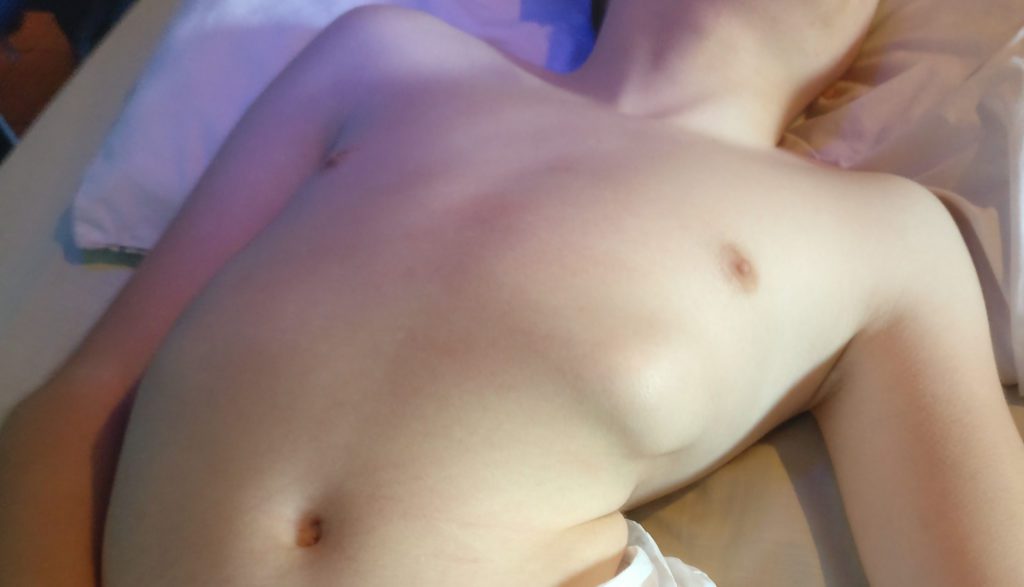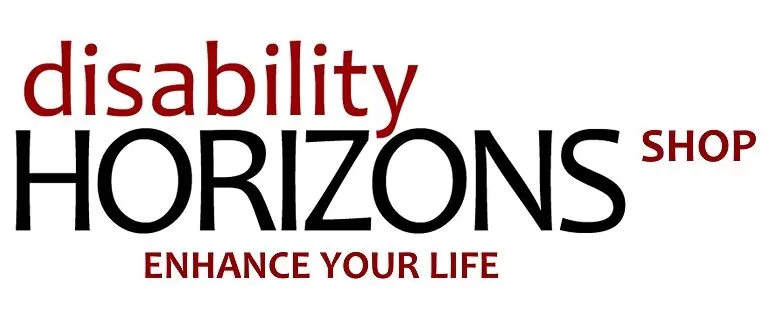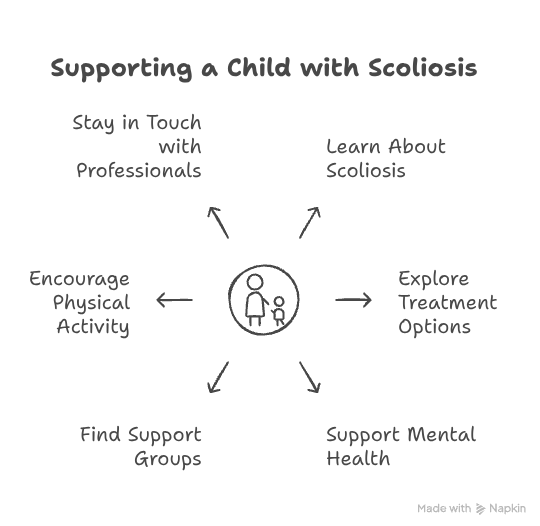Finding out your child has scoliosis is hugely worrying for a parent. You may be wondering what the diagnosis means, what kind of care your child will need, and how to make the best decisions for their comfort and wellbeing. These aren’t easy questions—but they’re familiar to every parent in the same position. This article offers honest, practical insights drawn from my experience supporting a child with complex needs. Here’s what we learned—often the hard way—and what we’d want other families to know – Duncan Edwards
Key Takeaways
| Tip | Why It Matters |
|---|---|
| Learn about scoliosis | Helps you respond to your child’s questions and guide their care confidently |
| Explore treatment options | Understanding braces, therapy, and surgery helps with decision-making |
| Support their mental health | Reduces emotional distress and boosts self-esteem |
| Find support groups | Helps both you and your child feel less isolated |
| Encourage safe physical activity | Movement improves strength, flexibility, and mood |
| Stay in touch with professionals | Timely care can reduce long-term complications |
Learn What Scoliosis Really Means
Scoliosis is where the spine twists and curves to the side.
It can affect people of any age, from babies to adults, but most often starts in children aged 10 to 15.
Scoliosis can improve with treatment, but it is not usually a sign of anything serious and treatment is not always needed if it’s mild.
Scoliosis is a condition characterised by an abnormal curvature of the spine, often appearing as an S-shape or C-shape when viewed from behind. It’s a sideways curve of the spine, and can occur in any age group, but is most commonly diagnosed in children and teens. This sideways curve of the spine can affect posture, growth, and sometimes even their ability to sit or stand comfortably.

In our case although we knew Joe had Dravet’s Syndome, a severe and complex epilepsy, scoliosis wasn’t something we were warned about. We were so consumed with managing his seizures that the scoliosis caught us off guard. Around age seven, when his epilepsy was more stable, he started complaining about hip pain. X-rays revealed the need for pelvic surgery—and that’s when the scoliosis was first diagnosed too.
I later learned that scoliosis is quite common in children with Dravet. If I’d known earlier, I would have been watching for it. If your child has a condition that increases the risk, ask about regular spine x-rays as part of their care.
Know the Risks
What Joe’s Story Taught Us About Hidden Risk
Some conditions make scoliosis more likely—but that risk isn’t always flagged early. In our son Joe’s case, we knew he had Dravet syndrome, But we didn’t know that studies suggest that nearly 1 in 5 children with Dravet go on to develop scoliosis, most often as they reach middle childhood or adolescence. It’s now recognised as a common comorbidity in Dravet, often alongside issues with walking, posture, and overall skeletal alignment.
Scoliosis wasn’t on our radar. Spine checks weren’t a regular part of Joe’s care, and like many parents, we assumed we’d be told if there was something to worry about. His scoliosis was only picked up when he needed pelvic surgery for hip pain—by then, the curve was already significant.
What we found is that unless a child shows obvious signs—like uneven shoulders, discomfort, or posture changes—X-rays often aren’t done routinely. Even once scoliosis is diagnosed, follow-up imaging is usually spaced out, partly to limit radiation exposure. That makes sense, but it can also mean delays in spotting when things are getting worse.
Joe’s case isn’t unique. Any child with a condition that affects muscle tone, posture, or mobility may be more prone to spinal issues. And while that doesn’t mean they’ll definitely develop scoliosis, it does mean it’s worth asking questions early. Could regular seating reviews help? Would a routine spinal check be appropriate? What signs should you be watching for at home?
If I’d known back then what I know now, I would’ve been pushing for monitoring much earlier.
If your child’s condition carries a known scoliosis risk, it’s completely reasonable to raise this with your care team. Ask whether regular spinal assessments are appropriate, and whether seating reviews or imaging might help pick things up earlier—before bigger interventions are needed.
Know What Treatment Involves
Scoliosis treatment doesn’t follow a set route there are various treatments and options available. What works depends on the child’s age, spine development, curve severity, and overall health. Options include observation, bracing, physiotherapy, and sometimes surgery.
We looked into elasticated posture-correcting garments. Sadly, by the time we found them, Joe’s curve was too advanced. They might have helped if we’d caught things sooner, but with his temperature sensitivity and difficulties in getting dressed, it would’ve been tough regardless.
Surgery was offered, but after a lot of thought and discussion we said no. Joe had already broken bones during seizures, and the metal rods in his legs changed how his muscles pulled. That made more surgery feel like a risk we couldn’t take. Being non-mobile, with low bone density and sleep apnoea, we felt the risks for him far outweighed the possible gains.
These days, surgery is often recommended more cautiously. We were told that in the past, the goal was to “fix” the spine. Now, the focus is often on managing scoliosis, especially with modern seating systems and therapies that can offer good outcomes without major interventions.
I’d always suggest talking to other parents—and to disabled people themselves—before making big decisions.
Every child is different. Joe was non-mobile and always likely to remain that way, even with surgery. For a more mobile child, surgery might improve movement. But for Joe, it wasn’t going to change that.
If bracing is recommended, take time to learn about the scoliosis bracing treatment options. Braces can be effective but only when worn consistently—something that can be tough for a child and family who are already dealing with complex health needs.
Look After Mental and Emotional Wellbeing
Scoliosis can affect how a child feels about their body—especially during teenage years, when so much hinges on appearance and fitting in. That pressure can lead to self-consciousness, especially if a brace is involved or their posture looks noticeably different.
With Joe, he is non-verbal and very much lives in the moment. He attended a special school where other children and staff were very supportive and physical differences were everywhere!
Puberty meant growth spurts, but his specialised seating for his wheelchair wasn’t changed frequently enough to keep up. We saw the impact clearly. He became unsettled, tense, and uncomfortable. Meals were harder, and he withdrew more.
Delays from NHS wheelchair services left us stuck, so we went private with SOS Seating. The difference was enormous—not just in his posture, but in his happiness and ability to eat and drink safely.
Not every child will react the same way. A more social or chatty child might worry about how they look, get embarrassed about wearing a brace, or pull away from things they used to enjoy. Some might push back against treatment altogether—not out of stubbornness, but because they’re overwhelmed.
It’s worth keeping an eye on, even when nothing seems wrong. Ask about comfort, friends, school, anything that gives a window in. If they don’t want to talk, that’s okay—just keep the space open. And if you think they’d benefit from extra support, look into counselling options that understand disability and the extra layers it brings.
Positive self-talk helps, too. Not as a fix-all—but as one small way to balance out the negative chatter. Remind your child that their body belongs to them, whatever shape it takes. And if they’re old enough, connecting with others in similar situations—online or in person—can help in ways parents often can’t.
Keep an eye out for bigger changes: withdrawal, low mood, sleep issues, a drop in interest. If any of that shows up, don’t leave it. Talk to your GP or therapist. Physical care is only half the story—mental wellbeing matters just as much.
Find Your Community
Being around others who have “been there” can be a lifeline. Online and in-person support groups give you space to share ideas, ask questions, and feel less alone.
We found our people in a Facebook group for Dravet parents. That’s where I first realised just how many of the children had scoliosis. The group helped me see patterns, learn what to ask consultants and surgeons, and swap ideas about equipment and care. I also found out what was really involved in the surgery and the likely outcomes.
I still visit online forums regularly to offer support, always reminding myself that treatments evolve fast and things may be better or different now. I try to ‘pay it forward’ in gratitude to the parents who came before and helped me.
If you’re not sure where to start, ask your child’s doctor or search for scoliosis-focused forums and charities. Hospitals that specialise in scoliosis often run support groups too. Also see our resource section at the bottom of this post.
Just as important: give yourself permission to dip in and out when you need to. Not every conversation is helpful when you’re already overwhelmed. And in good times, you may just want to be away from anything potentially distressing that reminds you of the past and focus on family life.
Keep Them Moving—Safely
Exercise can help manage scoliosis—but only if it’s safe and realistic for your child. Gentle, consistent movement improves circulation, flexibility, and mood.
For us, traditional therapies weren’t always possible. After Joe had leg surgery, he couldn’t safely use his standing frame due to low bone density. So we focused on what he could do. That meant gentle stretches, repositioning, and keeping his seating well-adjusted.
Every child’s needs are different. Let them lead. Pick activities they enjoy—walking, swimming, or anything low-impact. Involve the whole family to make it feel fun, not forced. Start slow and build up gradually. And if you’re not sure what’s safe, speak to a physio or paediatrician.
The NHS has helpful advice on managing scoliosis through exercise, but always check with your own clinical team.
Don’t Wait to Ask for Help—And Don’t Be Afraid to Push
Even if things feel manageable for now, it’s worth staying closely connected to your child’s care team. Scoliosis can move quickly during growth spurts, and the earlier it’s picked up, the more options you usually have.
In our experience, delays through NHS wheelchair services meant Joe spent far too long in discomfort. Eventually, we made the decision to go private and the difference was immediate—better posture, less pain, improved sleep. It shouldn’t have taken so long.
With current waiting lists and stretched services, you have to take on the role of project manager and advocate. That means chasing up referrals, following up on results, double-checking appointment dates, and asking again if something feels off.
You arent being a “difficult parent”. You are actively managing your child’s care. Unfortunately, that is absolutely what is needed now because of the current disarray in the NHS.
If you’re not getting what you need through one route, ask about alternatives. There may be other providers, or charitable support to help with assessments or equipment.
And above all, trust your instincts. You know your child best. If something feels urgent, speak up. Keep speaking up.
Supporting a child with scoliosis isn’t easy
It takes patience, persistence, and a willingness to adapt—often in the face of systems that move slowly or don’t quite fit your child’s needs. With Joe, we’ve had to make tough calls without all the answers and push hard for the right support. What I’ve learned is this: the small wins matter. The right seating, the right conversation at the right time—they can change everything. The road can be hard, but there’s also room for comfort, connection, and dignity along the way. I’m sharing our story in the hope that it helps other families feel a little less alone—and a little more confident in finding their own way forward.
Useful Links and Support Resources
If you’re looking for support, information, or community around scoliosis, here are some trusted resources:
UK Support and Information
- Scoliosis Support & Research (formerly Scoliosis Association UK) – The main UK charity offering helplines, peer support, and a specialist directory
- British Scoliosis Society – Provides patient information and connects you with specialists
- Find a Specialist Tool – Directory of NHS and private scoliosis experts in the UK
- SWS Cymru – Support With Scoliosis, a Welsh charity offering regional support
Online Communities
- National Scoliosis Foundation Forum – International community for patients, parents and professionals
- Scoliosis Warriors – One of the world’s largest online scoliosis communities
- Reddit Scoliosis Community – Active forum for asking questions and sharing experiences
Specialized Support
- Curvy Girls – Support network for girls and young women with scoliosis
- ScoliBoys – Facebook group for boys with scoliosis and their parents
- NHS Scoliosis Information – Official guidance and treatment options
Need immediate support? Contact Scoliosis Support & Research’s helpline at 020 8964 1166 or email info@ssr.org.uk.
About the Author: Duncan Edwards
Through my work with Disability Horizons Shop and supporting disabled families, I continue to share honest, practical advice rooted in lived experience and work closely with disabled entrepreneurs and help source inclusive products that actually make a difference.
Experience taught me the power of community-led solutions—whether that’s better products, clearer information, or simply knowing you’re not alone. For guest posts and writing commissions, please contact me via Linkedin

